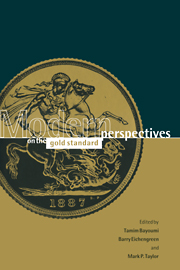Book contents
- Frontmatter
- Contents
- List of figures
- List of tables
- Notes on the contributors
- I Introduction
- II Operation of the gold standard
- 3 The gold standard as a commitment mechanism
- 4 Market efficiency and regime efficiency under the 1925–1931 dollar/sterling gold standard
- 5 Credibility and fundamentals: were the Classical and interwar gold standards well-behaved target zones?
- III Adjustment mechanisms
- IV Monetary issues
- V Exchange rate behavior
- VI Conclusions
- Index
3 - The gold standard as a commitment mechanism
Published online by Cambridge University Press: 05 November 2011
- Frontmatter
- Contents
- List of figures
- List of tables
- Notes on the contributors
- I Introduction
- II Operation of the gold standard
- 3 The gold standard as a commitment mechanism
- 4 Market efficiency and regime efficiency under the 1925–1931 dollar/sterling gold standard
- 5 Credibility and fundamentals: were the Classical and interwar gold standards well-behaved target zones?
- III Adjustment mechanisms
- IV Monetary issues
- V Exchange rate behavior
- VI Conclusions
- Index
Summary
Introduction
The gold standard has been a subject of perennial interest to both economists and economic historians. Attention has focused on three aspects of the gold standard's performance: as an international exchange rate arrangement; as a provider of macroeconomic stability; and as a constraint on government policy actions.
The balance of payments adjustment mechanism, or the links between the money supplies, price levels, and real outputs of different countries under fixed exchange rates, has long been studied as the key aspect of the international exchange rate arrangement of the gold standard. The durability of fixed exchange rates, the absence of exchange market crises, and the smooth adjustment to the massive transfers of capital in the decades before 1914 have been features stressed in monetary reform proposals ever since.
The gold standard has often been viewed as ensuring long-run, though not necessarily short-run, price stability via the operation of the Classical commodity theory of money. Recent comparisons between the classical gold standard and subsequent managed fiduciary monetary regimes suggest, however, that the record is mixed with respect both to price level and real output performance.
Finally, the gold standard has also been viewed as a form of constraint over monetary policy actions – as a form of monetary rule. The Currency School in England in the early 19th century made the case for the Bank of England's fiduciary note issue to vary automatically with the level of the Bank's gold reserve (“the currency principle”).
- Type
- Chapter
- Information
- Modern Perspectives on the Gold Standard , pp. 55 - 100Publisher: Cambridge University PressPrint publication year: 1997
- 9
- Cited by

